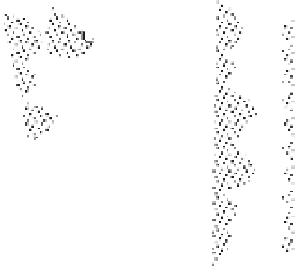Geology Reference
In-Depth Information
Basins and Faults in Extensional Terranes
2
1
marine or lake
or playa basin
large axial
delta
7
3
4
6
Fig. 10.11
Summary of drainage
geometries in extensional basins.
Active normal faults (3, 8, and 13)
have short, steep drainages
adjacent to the fault and longer,
gentler drainages on the back-
tilted flank, which are commonly
hanging-wall basins. Large
catchments oriented oblique to
the range front occur near fault
terminations and step-overs, such
as between faults 3 and 8 or
between 2 and 6. Large oblique
drainages (A and B) mark the
terminations of fault 9, which
have become inactive due to the
propagation of faults 4 and 10.
Abandonment of fault 2 as fault 1
becomes active causes large
catchments to form in the
sediments of the footwall to fault 1.
Axial rivers tend to be deflected
toward the more active basin
margin. Closed basins develop
near faults 5 and 11. Modified after
Leeder and Jackson (1993).
5
A
9
8
10
B
11
12
13
active fault
axial drainage
coastal plain/
deltaic sediment
drainage basin
alluvial fan/bajada
inactive fault
where most of the catchments are small and
orthogonal to the fault (Figs 10.11 and 10.12).
In the Basin and Range, comparison of the
overlapping Pearce and Tobin Faults in Pleasant
Valley, Nevada (Fig. 10.12), shows that the size
of the fans, the amount of topographic relief,
and the size of the footwall catchments all
decrease toward the tip of the propagating
young fault and toward the zone of overlap,
whereas the amount of entrenchment and the
distance of the active fanhead from the fault
trace increase in the same direction.
Displacement gradients and fault linkage
Theoretical calculations indicate that hanging-
wall subsidence and footwall uplift should be
maximized where fault displacement is the
greatest (King and Ellis, 1990). For faults that
propagate symmetrically from an initial central
rupture, this theory implies that maximum sub-
sidence and fault displacement should occur
near the mid-point of the fault trace (Fig. 4.10A).
At the same time, we know that, as multiple
faults propagate along a given trend, either they
































































































































































































































































































































































































































































